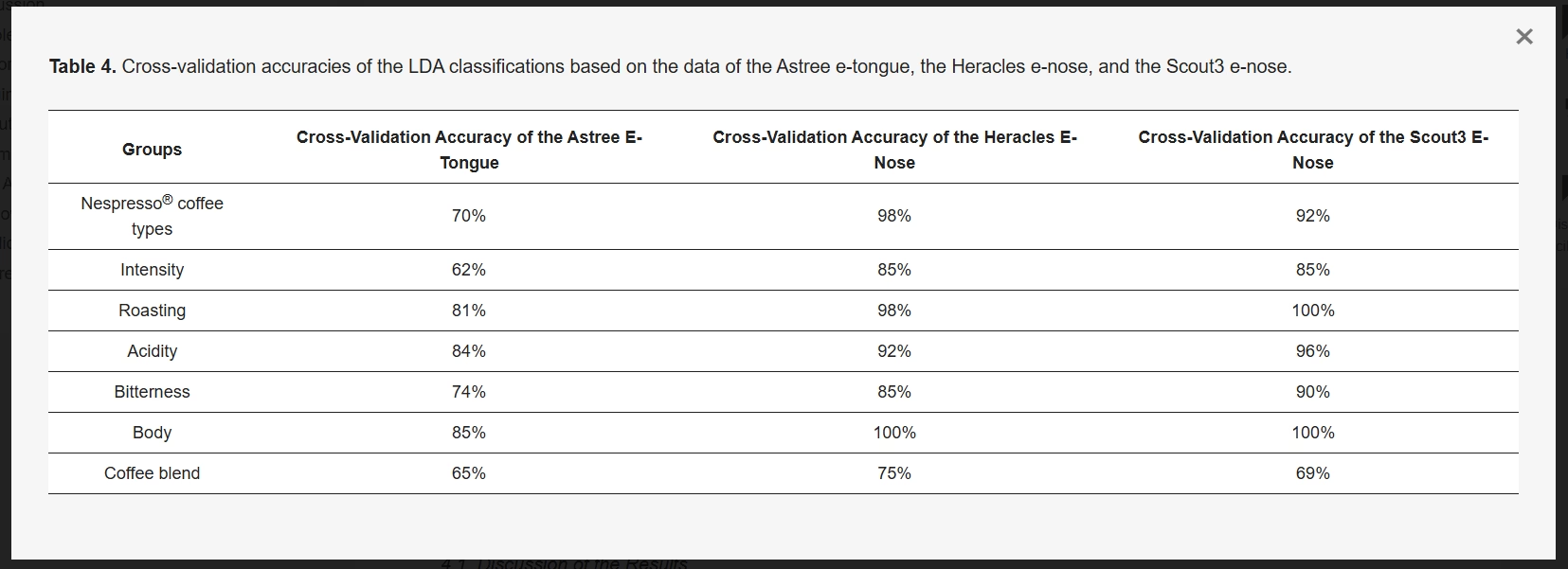How Electronic Sensing Technology is Reshaping the Future of Coffee Analysis

In an effort to revolutionize quality control across the industry, a recent study demonstrates how electronic sensing technologies can be used to analyze coffee aromas.
BY BHAVI PATEL
BARISTA MAGAZINE ONLINE
Featured photo courtesy of Milles Studio
Coffee professionals have long relied on human sensory panels to evaluate coffee quality, but groundbreaking research is changing how we analyze coffee aroma and taste. A recent study published in Chemosensors demonstrates how standardized coffee capsules have been used for comparing different electronic aroma detection technologies, potentially helping transform quality control in the coffee industry.
What is Electronic Sensing Technology?
Electronic sensing technologies are rapidly gaining ground in food analysis, and there are two main methods: the use of “electronic noses” and the use of “electronic tongues.”
Electronic noses use gas sensors to detect and analyze volatile aroma compounds, mimicking human smell perception, while electronic tongues employ chemical sensors to assess taste characteristics like bitterness, acidity, and body in liquid samples. These technologies offer significant advantages over traditional human sensory panels by eliminating subjectivity, reducing costs, speeding up testing processes, and providing consistent results regardless of human factors like fatigue or individual taste variations.
The Capsule Coffee Study: A Standardized Approach
In the study published by Chemosensors, researchers used eight different Nespresso coffee capsules—each representing a different coffee origin and flavor profile—to compare three electronic sensing technologies: the Astree electronic tongue, the Heracles electronic nose, and the Scout3 electronic nose. The capsules included varieties from Ethiopia, India, Brazil, Costa Rica, and Colombia, spanning both arabica and robusta blends with varying intensity levels.
The study’s innovative approach used commercially available coffee capsules as standard samples that researchers worldwide can access, creating a reproducible testing methodology for comparing different aroma fingerprinting technologies.
Key Findings: Which Technology Performs Best?
The results revealed distinct performance differences among the three technologies. The Heracles electronic nose emerged as the top performer with 98% accuracy in distinguishing different coffee types, successfully identifying subtle differences between regular and decaffeinated versions of the same coffee while excelling at detecting roasting levels with 98% accuracy. The Scout3 electronic nose also delivered strong performance with 92% accuracy for coffee type identification and perfect accuracy for detecting roasting characteristics and body parameters.
The Astree Electronic Tongue showed the lowest overall accuracy at 70% for coffee type discrimination, but performed well in detecting acidity differences at 84% accuracy, highlighting its strength in taste-related parameters.


According to the study, “The results of the Astree electronic tongue and those of the Heracles electronic nose showed the taste and smell profiles of the decaffeinated coffees to be different from their caffeinated counterparts. The Heracles and Scout3 electronic noses provided high accuracy in classifying the samples based on their odor into the sensory classes presented on the coffee capsules’ packaging.”
Impact on Coffee Quality Control
This research has significant implications for coffee roasters, importers, and quality control professionals. The ability to use standardized coffee capsules as reference samples means coffee businesses can implement consistent quality standards across different locations and testing facilities while reducing reliance on expensive human sensory panels. The technology speeds up quality assessment processes from hours to minutes and can detect subtle differences in decaffeinated versus regular coffee products while objectively measuring roasting levels and flavor intensity.
According to the researchers, “This study demonstrates a simple and cost-effective method to compare different aroma fingerprinting technologies based on measuring coffees brewed from standard coffee capsules.”



Why This Matters for Coffee Professionals
The study’s most practical contribution is establishing a globally accessible testing framework. Since Nespresso capsules are available and consistent worldwide, coffee professionals can use identical reference samples to calibrate and compare different electronic sensing equipment. This standardization addresses a long-standing challenge in coffee quality control regarding the lack of consistent reference materials for equipment comparison. Now, a roaster in Guatemala can use the same reference standards as a quality control lab in Germany, ensuring more reliable and comparable results.
“Since the coffee capsules used for the test can be purchased all over the world in the same quality, these coffees can be used as global standard samples during the comparison of different devices applying different measurement technologies. The test can be used to evaluate instrumental and data analytical developments worldwide and to assess the potential of novel, cost-effective, accurate, and rapid solutions for quality assessments in the food and beverage industry,” share the researchers in the study.



The Future of Coffee Analysis
Electronic sensing technology represents a paradigm shift toward more objective, efficient coffee analysis. While human sensory evaluation remains valuable for understanding consumer preferences, electronic systems excel at consistent, repeatable measurements crucial for quality control and process optimization. The research demonstrates that different electronic technologies complement each other, with electronic noses excelling at detecting aroma compounds and roasting characteristics while electronic tongues provide detailed taste profile analysis.
Coffee businesses can leverage these findings by investing in electronic sensing equipment appropriate for their specific quality control needs, using standardized capsule references to validate equipment performance, and implementing hybrid approaches that combine electronic analysis with selective human sensory evaluation. This research marks a significant step toward more scientific, standardized approaches to coffee quality assessment, promising greater consistency and efficiency in how we evaluate coffee quality across the global coffee industry.
ABOUT THE AUTHOR
Bhavi Patel is a food writer focusing on coffee and tea, and a brand-building specialist with a background in dairy technology and an interest in culinary history and sensory perception of food.
Subscribe and More!
As always, you can read Barista Magazine in paper by subscribing or ordering an issue.
Read the June + July 2025 Issue for free with our digital edition.
For free access to more than five years’ worth of issues, visit our digital edition archives here.
Source: Barista Magazine



